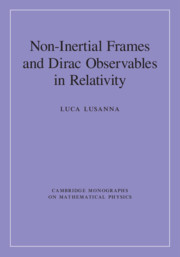Book contents
- Frontmatter
- Dedication
- Contents
- Preface
- Part I Special Relativity: Minkowski Space-Time
- 1 Galilei and Minkowski Space-Times
- 2 Global Non-Inertial Frames in Special Relativity
- 3 Relativistic Dynamics and the Relativistic Center of Mass
- 4 Matter in the Rest-Frame Instant Form of Dynamics
- Part II General Relativity: Globally Hyperbolic Einstein Space-Times
- Part III Dirac–Bergmann Theory of Constraints
- Appendix A Canonical Realizations of Lie Algebras, Poincaré Group, Poincar´e Orbits, and Wigner Boosts
- Appendix B Grassmann Variables and Pseudo–Classical Lagrangians
- Appendix C Relativistic Perfect Fluids and Covariant Thermodynamics
- References
- Index
4 - Matter in the Rest-Frame Instant Form of Dynamics
from Part I - Special Relativity: Minkowski Space-Time
Published online by Cambridge University Press: 17 June 2019
- Frontmatter
- Dedication
- Contents
- Preface
- Part I Special Relativity: Minkowski Space-Time
- 1 Galilei and Minkowski Space-Times
- 2 Global Non-Inertial Frames in Special Relativity
- 3 Relativistic Dynamics and the Relativistic Center of Mass
- 4 Matter in the Rest-Frame Instant Form of Dynamics
- Part II General Relativity: Globally Hyperbolic Einstein Space-Times
- Part III Dirac–Bergmann Theory of Constraints
- Appendix A Canonical Realizations of Lie Algebras, Poincaré Group, Poincar´e Orbits, and Wigner Boosts
- Appendix B Grassmann Variables and Pseudo–Classical Lagrangians
- Appendix C Relativistic Perfect Fluids and Covariant Thermodynamics
- References
- Index
Summary
In this chapter there is the description of fields and fluids in the rest-frame instant form of dynamics with the definition of their Wigner-covariant degrees of freedom inside the Wigner 3-spaces after the decoupling of the external center of mass. This is done for the Klein–Gordon, electromagnetic, Dirac, and Yang–Mills fields. In the case of the electromagnetic field there is the identification of the Wigner-covariant Dirac observables. This procedure can be applied also to Yang–Mills fields, but to get the Dirac observables one needs the knowledge of an explicit solution of the Gauss’s law constraints. Then there is the description of relativistic fluids in this framework. In particular a definition of the relativistic micro-canonical ensemble in the Wigner 3-spaces is given and it is shown which equations have to be solved to get a consistent relativistic statistical mechanics.
Keywords
- Type
- Chapter
- Information
- Non-Inertial Frames and Dirac Observables in Relativity , pp. 54 - 118Publisher: Cambridge University PressPrint publication year: 2019

